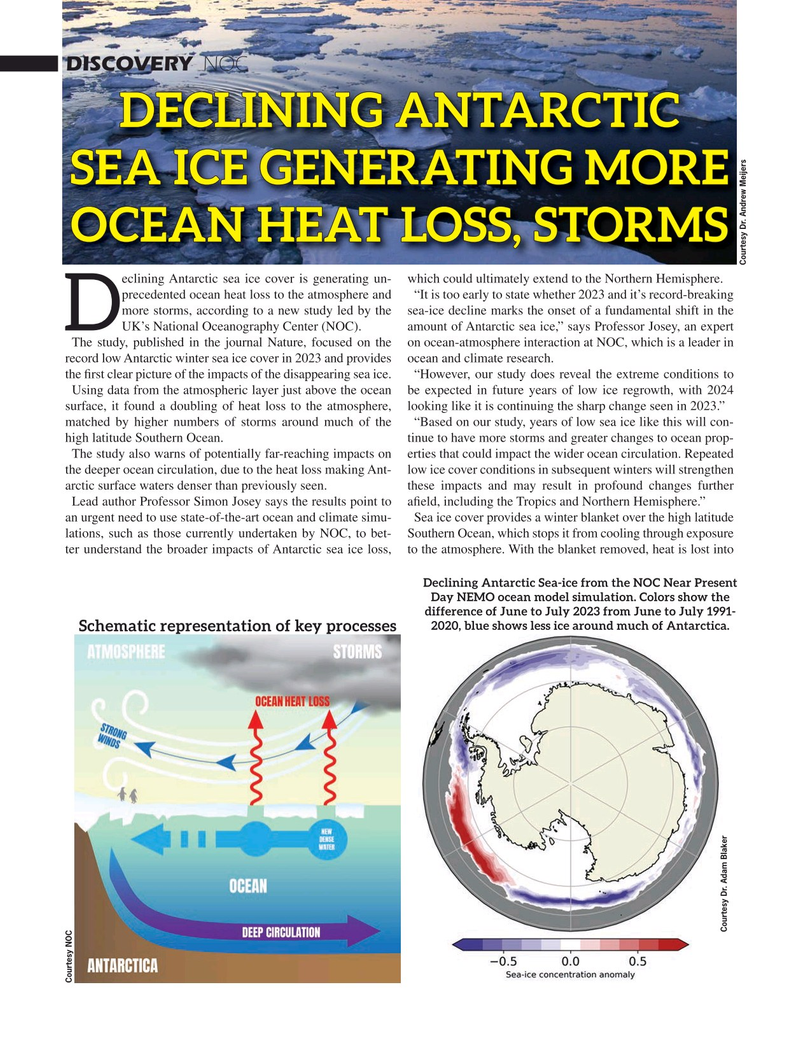
Page 16: of Marine Technology Magazine (January 2025)
Read this page in Pdf, Flash or Html5 edition of January 2025 Marine Technology Magazine
DISCOVERY NOC
DECLINING ANTARCTIC
SEA ICE GENERATING MORE
OCEAN HEAT LOSS, STORMS
Courtesy Dr. Andrew Meijers eclining Antarctic sea ice cover is generating un- which could ultimately extend to the Northern Hemisphere.
precedented ocean heat loss to the atmosphere and “It is too early to state whether 2023 and it’s record-breaking more storms, according to a new study led by the sea-ice decline marks the onset of a fundamental shift in the
DUK’s National Oceanography Center (NOC). amount of Antarctic sea ice,” says Professor Josey, an expert
The study, published in the journal Nature, focused on the on ocean-atmosphere interaction at NOC, which is a leader in record low Antarctic winter sea ice cover in 2023 and provides ocean and climate research.
the ? rst clear picture of the impacts of the disappearing sea ice. “However, our study does reveal the extreme conditions to
Using data from the atmospheric layer just above the ocean be expected in future years of low ice regrowth, with 2024 surface, it found a doubling of heat loss to the atmosphere, looking like it is continuing the sharp change seen in 2023.” matched by higher numbers of storms around much of the “Based on our study, years of low sea ice like this will con- high latitude Southern Ocean. tinue to have more storms and greater changes to ocean prop-
The study also warns of potentially far-reaching impacts on erties that could impact the wider ocean circulation. Repeated the deeper ocean circulation, due to the heat loss making Ant- low ice cover conditions in subsequent winters will strengthen arctic surface waters denser than previously seen. these impacts and may result in profound changes further
Lead author Professor Simon Josey says the results point to a? eld, including the Tropics and Northern Hemisphere.” an urgent need to use state-of-the-art ocean and climate simu- Sea ice cover provides a winter blanket over the high latitude lations, such as those currently undertaken by NOC, to bet- Southern Ocean, which stops it from cooling through exposure ter understand the broader impacts of Antarctic sea ice loss, to the atmosphere. With the blanket removed, heat is lost into
Declining Antarctic Sea-ice from the NOC Near Present
Day NEMO ocean model simulation. Colors show the difference of June to July 2023 from June to July 1991- 2020, blue shows less ice around much of Antarctica.
Schematic representation of key processes
Courtesy Dr. Adam Blaker
Courtesy NOC
MTR #1 (1-17).indd 16 2/3/2025 11:26:10 AM

 15
15

 17
17
